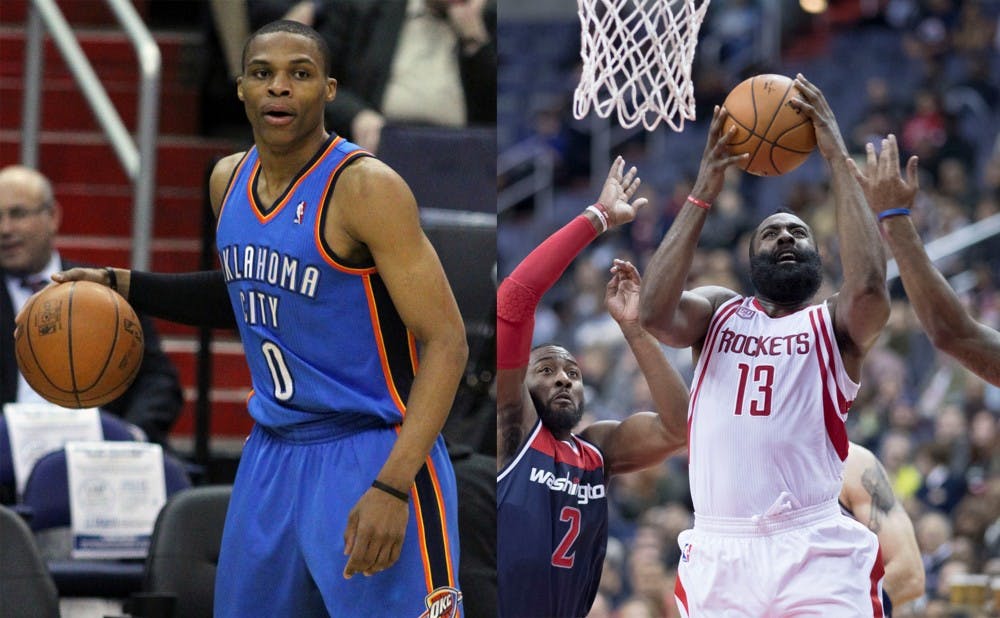Russell Westbrook has to be the NBA’s Most Valuable Player this season. Right?
He is on track to be the first player since the legendary Oscar Robertson—all the way back in the 1961-62 season—to average a triple-double during the course of the regular season.
But there are a couple of people standing in his way, all of whom are on teams with far better records—namely James Harden, LeBron James, Kevin Durant and Kawhi Leonard.
Harden in particular is challenging Westbrook by stuffing the stat sheet on a nightly basis. He is averaging 28.4 points, 11.7 assists and 8.2 rebounds per game, and his team is 6.5 games ahead of Westbrook’s, adding intrigue even though Harden might have a better supporting cast.
The same argument follows in college basketball, where a little-known player outside of basketball geeks named Alec Peters is having a season to remember for an unranked Valparaiso team, keeping the Crusaders alive in the Horizon League without much support around him. Yet players like Villanova swingman Josh Hart, UCLA freshman phenom Lonzo Ball, Kansas’ Frank Mason III and even Duke sharpshooter Luke Kennard are consistently ranked above Peters in nearly every Wooden Award—the NCAA’s National Player of the Year award—projection.
So who really deserves the most valuable player awards? Should it be to the best player on one of the top teams, or truly the most valuable player in the NBA or NCAA?
I think there are different answers for the different leagues, especially when taking the total size of the associations into account.
After all, there are 347 Division I men’s basketball squads and only 30 in the NBA, meaning that there are far fewer players in professional basketball than in college.
For such well-known awards, the winner should be a recognizable player, which differs based on the league. With a maximum of only 450 professionals on all NBA rosters combined, each player gets constantly scrutinized, with the best rising to the top regardless of his team’s performance.
The best example might be Philadelphia 76ers rookie Joel Embiid, who has been constantly making headlines despite playing for one of the NBA’s perennial bottom-feeders. Now that the 76ers have won six of eight games, that attention is only starting to grow.
For professional basketball, I am claiming that Russell Westbrook should be the MVP frontrunner.
Westbrook carries the Thunder. Actually, carry might be an understatement. He has by far the highest usage rate in the league at better than 41 percent, yet also registers the highest player efficiency rating and estimated wins added. Perhaps the best evidence for Westbrook is also the product Oklahoma City puts on the court with him on the bench—it’s often hard to watch.
But in the NCAA, the discussion becomes much murkier if mid-major superstars such as Peters are included in the realistic Wooden Award nominees.
From a casual fan’s perspective, only a handful of games—at best—will be televised for Valparaiso. Chances are, the contests will not be on national television, so most viewers will have never seen a guy like Peters perform prior to the NCAA tournament, which his Crusaders may not even make as they currently sit tied for second in their conference standings.
For the Wooden Award, it is easier to rally behind the best player from a blue-blood program, or occasionally, an athlete with a reputation that precedes him. Prodigious scorers Jimmer Fredette and Doug McDermott took the college hoops world by storm en route to their National Player of the Year awards at Brigham Young and Creighton, respectively.
But those teams were also top-25 teams that earned No. 3 seeds in the NCAA tournament.
Whereas in the NBA, every player has plenty of media exposure, only those on teams with legitimate national title aspirations and high-profile programs get exposure until March, when everybody suddenly becomes a bracketology expert. What if that mid-major program loses in the first round? Then its star player may only have one or two matchups to prove his worth, compared to players like Kennard or Grayson Allen, who both often play on national television multiple times per week starting in January.
Unfortunately, in the NCAA, only about 30 teams receive the same exposure as NBA franchises, with automatic guarantees for nationally recognized programs such as Syracuse, which has already lost seven times this year and fell at home by 33 to now 9-11 St. John’s. Therefore, the Wooden Award nominees are chosen from only a select group of teams, thus virtually eliminating athletes such as Peters from realistic nomination.
Is it a shame? Yes.
Some of the truly most valuable players will almost never receive recognition for the Wooden Award. But regardless, the NCAA’s voting committee is making the right decision by selecting the best players from the most popular teams, as they tend to be the most recognizable athletes to the casual fan.
This is the main reason Kennard will probably receive more votes for the Wooden Award than Peters, who is averaging nearly four points and five rebounds more than Kennard this season. In addition to shooting a much higher percentage and taking on other well-known teams, Kennard plays for one of the sport’s biggest brands.
That’s the unfortunate reality of college basketball awards, and why fans should try to watch a few lesser-known players when they’re not gawking at Westbrook’s latest triple-double.
Get The Chronicle straight to your inbox
Signup for our weekly newsletter. Cancel at any time.

